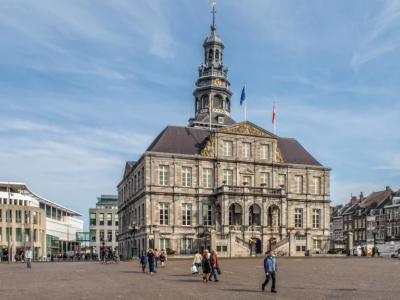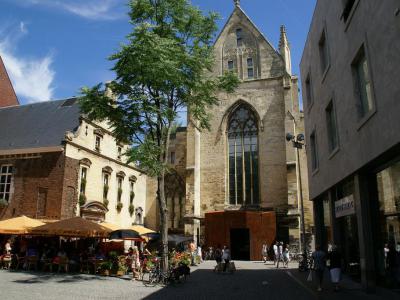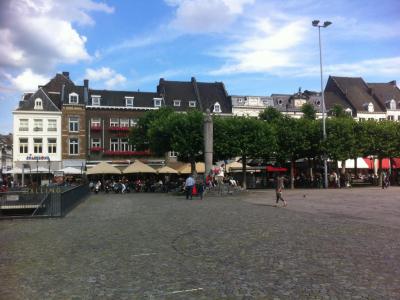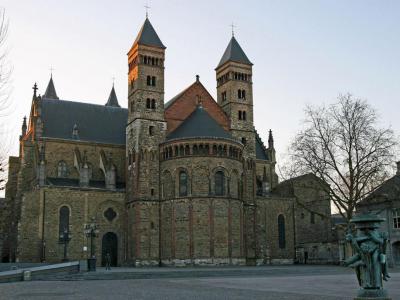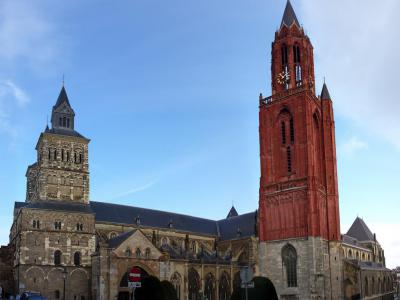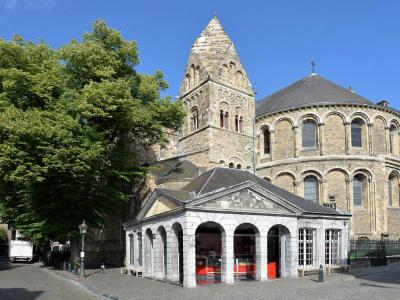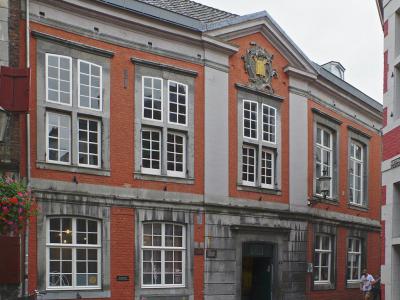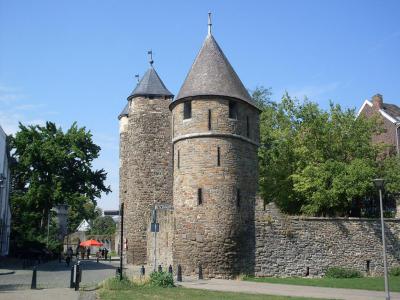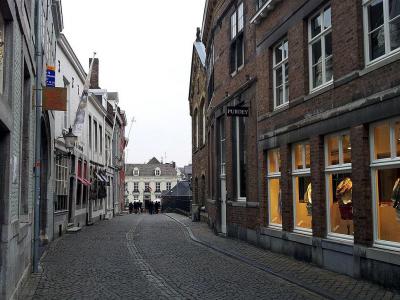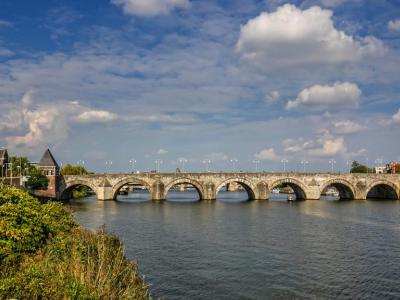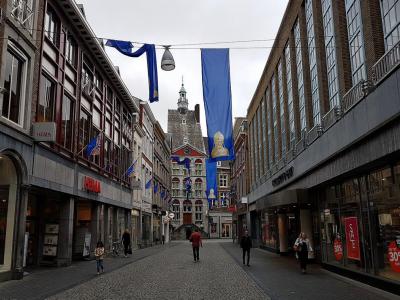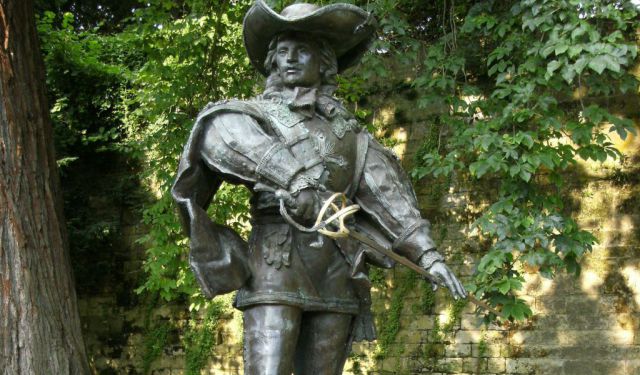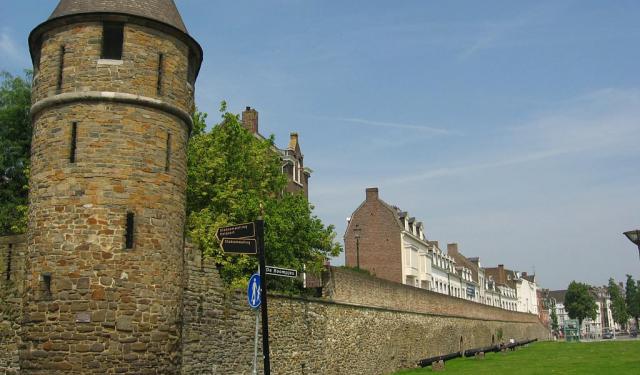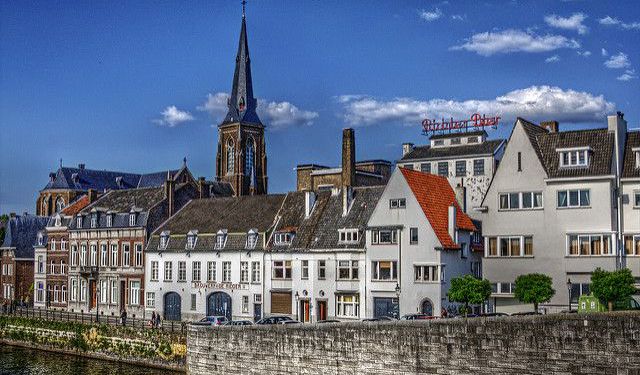
Maastricht Introduction Walking Tour (Self Guided), Maastricht
Maastricht is an ancient city known for its rich history, medieval architecture, and vibrant cultural scene.
In the first century AD, the Romans built a bridge across the Meuse river. A settlement grew near the bridge. Maastricht's name means "a place to cross the Meuse river". Today, a pillar marks this location of the original Roman bridge.
The Roman settlement was small, but excavations revealed a Roman road, shrine, a Roman bath, houses, a fourth-century castrum, jewelry, pottery, and coins.
Saint Servatius, the city's patron saint, was the Bishop of Tongeren and died in 384 along the Roman road. The Basilica of Saint Servatius is located on Saint Servatius's gravesite.
Maastricht was a vital part of the Carolingian Empire and was known for its manufacturing of wool and leather and trade capabilities. Maastricht flourished during the 12th century, and the city produced beautiful art and architecture.
The city remained an important trading center throughout the Middle Ages. However, Maastricht's economy suffered during the 16th and 17th-century wars of religion. First, the Spanish army sacked the city in 1579. Then, in 1632, Prince Frederick Henry of Orange conquered Maastricht. Next, Louis XIV of France laid siege to the city in 1673. Finally, the French conquered Maastricht in 1748 and again in 1794 when Napoleonic France annexed the city.
Maastricht's economy recovered during the industrial revolution in the early 19th century and the city joined the United Kingdom of the Netherlands in 1815. The city remained neutral during World War I and took in many refugees from Germany and Belgium. However, the Germans captured Maastricht during World War II before Allied forces liberated it.
Today, visitors can enjoy the city's many historical architectural wonders. The Romanesque Basilica of Saint Servatius was built during the 11th and 12th centuries. It stands next door to St. John's Church, built during the 14th and 15th centuries. The Romanesque Basilica of Our Lady was built in the 11th and 12th centuries and is another fabulous example of Maastricht's architectural history.
Visitors can taste fresh-baked bread at Holland's oldest working watermill, walk across the centuries-old St. Servatius Bridge, and admire Hell's Gate, part of the original city walls.
Take this self-guided tour to explore Maastricht's most notable sights.
In the first century AD, the Romans built a bridge across the Meuse river. A settlement grew near the bridge. Maastricht's name means "a place to cross the Meuse river". Today, a pillar marks this location of the original Roman bridge.
The Roman settlement was small, but excavations revealed a Roman road, shrine, a Roman bath, houses, a fourth-century castrum, jewelry, pottery, and coins.
Saint Servatius, the city's patron saint, was the Bishop of Tongeren and died in 384 along the Roman road. The Basilica of Saint Servatius is located on Saint Servatius's gravesite.
Maastricht was a vital part of the Carolingian Empire and was known for its manufacturing of wool and leather and trade capabilities. Maastricht flourished during the 12th century, and the city produced beautiful art and architecture.
The city remained an important trading center throughout the Middle Ages. However, Maastricht's economy suffered during the 16th and 17th-century wars of religion. First, the Spanish army sacked the city in 1579. Then, in 1632, Prince Frederick Henry of Orange conquered Maastricht. Next, Louis XIV of France laid siege to the city in 1673. Finally, the French conquered Maastricht in 1748 and again in 1794 when Napoleonic France annexed the city.
Maastricht's economy recovered during the industrial revolution in the early 19th century and the city joined the United Kingdom of the Netherlands in 1815. The city remained neutral during World War I and took in many refugees from Germany and Belgium. However, the Germans captured Maastricht during World War II before Allied forces liberated it.
Today, visitors can enjoy the city's many historical architectural wonders. The Romanesque Basilica of Saint Servatius was built during the 11th and 12th centuries. It stands next door to St. John's Church, built during the 14th and 15th centuries. The Romanesque Basilica of Our Lady was built in the 11th and 12th centuries and is another fabulous example of Maastricht's architectural history.
Visitors can taste fresh-baked bread at Holland's oldest working watermill, walk across the centuries-old St. Servatius Bridge, and admire Hell's Gate, part of the original city walls.
Take this self-guided tour to explore Maastricht's most notable sights.
How it works: Download the app "GPSmyCity: Walks in 1K+ Cities" from Apple App Store or Google Play Store to your mobile phone or tablet. The app turns your mobile device into a personal tour guide and its built-in GPS navigation functions guide you from one tour stop to next. The app works offline, so no data plan is needed when traveling abroad.
Maastricht Introduction Walking Tour Map
Guide Name: Maastricht Introduction Walking Tour
Guide Location: Netherlands » Maastricht (See other walking tours in Maastricht)
Guide Type: Self-guided Walking Tour (Sightseeing)
# of Attractions: 11
Tour Duration: 2 Hour(s)
Travel Distance: 2.2 Km or 1.4 Miles
Author: ellen
Sight(s) Featured in This Guide:
Guide Location: Netherlands » Maastricht (See other walking tours in Maastricht)
Guide Type: Self-guided Walking Tour (Sightseeing)
# of Attractions: 11
Tour Duration: 2 Hour(s)
Travel Distance: 2.2 Km or 1.4 Miles
Author: ellen
Sight(s) Featured in This Guide:
- Marktplaats (Market Square)
- Boekhandel Dominicanen (Dominicanen Bookstore)
- Vrijthof Square
- Basilica of Saint Servatius
- Sint-Janskerk (St. John's Church)
- Onze-Lieve-Vrouwekerk (Basilica of Our Lady)
- Bisschopsmolen (Bishop's Mill)
- Helpoort (Hell's Gate)
- Stokstraat (Stok Street)
- Sint Servaasbrug (St. Servatius Bridge)
- Grote Staat (Great Street)
1) Marktplaats (Market Square) (must see)
Market Square is home to Maastricht's most popular market. In addition, the square features Maastricht's city hall and numerous imposing mansions.
Market Square has hosted commodity markets for centuries. In Medieval times, the square was much smaller. In the 13th century, a cloth hall was built against the old city wall and traders would gather here. In 1659, the old city walls and the cloth hall were demolished to make way for the new City Hall.
City Hall was built by architect Pieter Post between 1659 and 1664. The building's tower dates to 1684. The 49-bell carillon chimes on the hour. City Hall's interior features stunning ceiling paintings, stucco work, and wall tapestries.
The square's current layout and most of the square's buildings were constructed in the 17th and 18th centuries.
The market operates every Wednesday and Friday. The Wednesday market features around 200 stalls. The Friday market is busier, with around 400 stalls.
Sellers offer plants, flowers, food items, fresh produce, cosmetics, and clothes. Market Square also features many permanent restaurants, boutiques, and stores.
A statue of Johanne Petrus Mincklelers stands in the center of the square. The statue is called "Eternal Burning Flame." Mincklelers invented illuminating gas, and his statue depicts him holding a gas torch. The gas torch is lit with natural gas, and visitors can feel the heat up-close.
The square features a bluestone fountain called Mooswief. The statue honors women who used the market to sell their vegetables.
Market Square has hosted commodity markets for centuries. In Medieval times, the square was much smaller. In the 13th century, a cloth hall was built against the old city wall and traders would gather here. In 1659, the old city walls and the cloth hall were demolished to make way for the new City Hall.
City Hall was built by architect Pieter Post between 1659 and 1664. The building's tower dates to 1684. The 49-bell carillon chimes on the hour. City Hall's interior features stunning ceiling paintings, stucco work, and wall tapestries.
The square's current layout and most of the square's buildings were constructed in the 17th and 18th centuries.
The market operates every Wednesday and Friday. The Wednesday market features around 200 stalls. The Friday market is busier, with around 400 stalls.
Sellers offer plants, flowers, food items, fresh produce, cosmetics, and clothes. Market Square also features many permanent restaurants, boutiques, and stores.
A statue of Johanne Petrus Mincklelers stands in the center of the square. The statue is called "Eternal Burning Flame." Mincklelers invented illuminating gas, and his statue depicts him holding a gas torch. The gas torch is lit with natural gas, and visitors can feel the heat up-close.
The square features a bluestone fountain called Mooswief. The statue honors women who used the market to sell their vegetables.
2) Boekhandel Dominicanen (Dominicanen Bookstore) (must see)
This unique bookstore features an independent bookstore located in a 13th-century church.
The Gothic-style cathedral was built in 1294. The church features a 14th-century fresco showing scenes from Thomas Aquinas' life. The fresco is known as Netherlands' oldest ecclesiastical wall painting. Other wall paintings date to the 1600s.
In 1794, Napolean Bonaparte used the church to house personnel and store equipment. After the monastery's dissolution in the 18th century, the church found a variety of other uses. For example, it was used as bike storage, a warehouse, a carnival, a boxing ring, and a printing house.
In 2006, the ancient church was converted into the Selexyx bookstore. The conversion project is known as Selexyz Dominicanen Maastricht. The conversion features open spaces, and the bookstore has been divided into three stories. The bookstore's design doesn't interfere with or detract from the church's stunning interior.
Selexyz became Polare, and Polare filed for bankruptcy. In 2014, the bookstore became independent and updated its name to Boekhandel Dominicanen. The bookstore features Dutch and English titles, children's books, art histories, travel guides, and more. In addition, the bookstore has a music department with vinyl records and CDs.
Over 150 events take place every year in the bookstore. Visitors can attend interviews with authors, readings, and debates.
The Dominicanen Bookstore also has a delightful cafe. Visitors can enjoy lunch and coffee in the former church's choir area.
Whether you are looking to peruse books, attend an event, grab a coffee, or enjoy the beauty of the ancient church, Dominicanen Bookstore is a must-see.
The Gothic-style cathedral was built in 1294. The church features a 14th-century fresco showing scenes from Thomas Aquinas' life. The fresco is known as Netherlands' oldest ecclesiastical wall painting. Other wall paintings date to the 1600s.
In 1794, Napolean Bonaparte used the church to house personnel and store equipment. After the monastery's dissolution in the 18th century, the church found a variety of other uses. For example, it was used as bike storage, a warehouse, a carnival, a boxing ring, and a printing house.
In 2006, the ancient church was converted into the Selexyx bookstore. The conversion project is known as Selexyz Dominicanen Maastricht. The conversion features open spaces, and the bookstore has been divided into three stories. The bookstore's design doesn't interfere with or detract from the church's stunning interior.
Selexyz became Polare, and Polare filed for bankruptcy. In 2014, the bookstore became independent and updated its name to Boekhandel Dominicanen. The bookstore features Dutch and English titles, children's books, art histories, travel guides, and more. In addition, the bookstore has a music department with vinyl records and CDs.
Over 150 events take place every year in the bookstore. Visitors can attend interviews with authors, readings, and debates.
The Dominicanen Bookstore also has a delightful cafe. Visitors can enjoy lunch and coffee in the former church's choir area.
Whether you are looking to peruse books, attend an event, grab a coffee, or enjoy the beauty of the ancient church, Dominicanen Bookstore is a must-see.
3) Vrijthof Square (must see)
Vrijthof Square is a large ancient square with beautiful cobblestones. It has been Maastricht's main square since the 19th century.
Excavations have revealed a late Roman period burial site underneath the square. Archeologists also found remains of an ancient Roman road, the Via Belgica under the square's north side.
The Vrijthof name was first mentioned in writing in 1223. Sometime after that, Vrijthof Square was walled. The walls were removed during the Maastricht Septennial Pilgrimage.
A stone perron was erected in the square in 1292 to symbolize the prince-bishop of Liège's jurisdiction. The French Occupation demolished this perron in 1795. The current perron stands in the square's northeast corner and was built in the 1950s.
The square was occasionally used for executions. In 1408, a rebellious Liège mayor was beheaded here. Fifteen Anabaptist heretics were burned at the stake in 1535.
In the 17th century, a fence replaced the wall. In the 17th and 18th centuries, the square served as a military parade ground. The Main Guard House was built in 1736.
During the 1794-1814 French Occupation, the square was renamed Arms Square. The French Occupation demolished several landmark buildings in the square.
Today, there are 38 heritage buildings in Vrijthof Square. The 11th-century Basilica of Saint Servatius stands next to the 14th century St. John's Church. The brightly colored 16th century Spanish Government building now houses the Museum of Photography.
Visitors will find a plaque dedicated to the US Army's Old Hickory Division which was instrumental in Masstricht's liberation in 1944. The square is also home to interesting artworks by local artists.
Excavations have revealed a late Roman period burial site underneath the square. Archeologists also found remains of an ancient Roman road, the Via Belgica under the square's north side.
The Vrijthof name was first mentioned in writing in 1223. Sometime after that, Vrijthof Square was walled. The walls were removed during the Maastricht Septennial Pilgrimage.
A stone perron was erected in the square in 1292 to symbolize the prince-bishop of Liège's jurisdiction. The French Occupation demolished this perron in 1795. The current perron stands in the square's northeast corner and was built in the 1950s.
The square was occasionally used for executions. In 1408, a rebellious Liège mayor was beheaded here. Fifteen Anabaptist heretics were burned at the stake in 1535.
In the 17th century, a fence replaced the wall. In the 17th and 18th centuries, the square served as a military parade ground. The Main Guard House was built in 1736.
During the 1794-1814 French Occupation, the square was renamed Arms Square. The French Occupation demolished several landmark buildings in the square.
Today, there are 38 heritage buildings in Vrijthof Square. The 11th-century Basilica of Saint Servatius stands next to the 14th century St. John's Church. The brightly colored 16th century Spanish Government building now houses the Museum of Photography.
Visitors will find a plaque dedicated to the US Army's Old Hickory Division which was instrumental in Masstricht's liberation in 1944. The square is also home to interesting artworks by local artists.
4) Basilica of Saint Servatius (must see)
The Romanesque Basilica of Saint Servatius is built on Saint Servatius's gravesite. It is likely that the current structure is the fourth iteration of churches on this site.
Saint Servatius was an Armenian missionary and Tongeren's bishop. He reportedly died in Maastricht in 384. The first church was a small memorial chapel, which was replaced by a larger church. Next, a pilgrim church was built. Finally, the current church was built between the 11th and 12th centuries. Emperor Henry III and a dozen bishops attended the church's dedication in 1039.
The impressive Berg Portal is located on the south side of the church and gives visitors access to the church via descending steps. The portal was probably built during the 12th and 13th centuries and is the first Gothic construction in Maastricht. An intricate tile labyrinth covers the floor.
The portal features vibrantly decorated walls and 72 statues of kings, prophets, apostles, saints, and angels. In addition, reliefs depict Mary's life. In 1566, many statues had their heads removed because of a cultural movement against icons. The damage was poorly repaired in 1596. A Baroque facade was added in the 18th century and removed in the 19th century.
The side chapels were added in the 14th and 15th centuries and feature Gothic architecture. A Gothic spire was added in 1556, and Baroque helmet spires were added in 1770.
French revolutionaries used the church as a horse stable in 1797. As a result, many of the church furnishings were sold or damaged. Since 1866, the church has undergone several restorations.
Throughout the Middle Ages, the Pilgrimage of the Relics took place every seven years. The pilgrimage was revived in the 19th century and again takes place every seven years.
Saint Servatius was an Armenian missionary and Tongeren's bishop. He reportedly died in Maastricht in 384. The first church was a small memorial chapel, which was replaced by a larger church. Next, a pilgrim church was built. Finally, the current church was built between the 11th and 12th centuries. Emperor Henry III and a dozen bishops attended the church's dedication in 1039.
The impressive Berg Portal is located on the south side of the church and gives visitors access to the church via descending steps. The portal was probably built during the 12th and 13th centuries and is the first Gothic construction in Maastricht. An intricate tile labyrinth covers the floor.
The portal features vibrantly decorated walls and 72 statues of kings, prophets, apostles, saints, and angels. In addition, reliefs depict Mary's life. In 1566, many statues had their heads removed because of a cultural movement against icons. The damage was poorly repaired in 1596. A Baroque facade was added in the 18th century and removed in the 19th century.
The side chapels were added in the 14th and 15th centuries and feature Gothic architecture. A Gothic spire was added in 1556, and Baroque helmet spires were added in 1770.
French revolutionaries used the church as a horse stable in 1797. As a result, many of the church furnishings were sold or damaged. Since 1866, the church has undergone several restorations.
Throughout the Middle Ages, the Pilgrimage of the Relics took place every seven years. The pilgrimage was revived in the 19th century and again takes place every seven years.
5) Sint-Janskerk (St. John's Church)
The Protestant St. John's Church is immediately next to the Roman Catholic Basilica of Saint Servatius. The churches are often referred to as the church twins.
St. John's Church is named after John the Baptist and was founded around 1200 by the chapter of Saint Servatius to function as a baptismal and parish church for the parish of Saint Servatius. This relieved the load on the Saint Servatius Church and allowed it to function exclusively as a collegiate and pilgrimage church.
St. John was one of Masstricht's four Catholic parish churches during the Middle Ages. The current structure was built in the 14th and 15th centuries. The Gothic baptistery was added in 1414.
During the medieval times, on the Saturdays before Easter and Pentecost, the canons of Saint Servatius went in procession to St. John to consecrate the baptismal water. On that occasion, the church choir sang to the canons from the first transept of St. John's.
St. John's became a Protestant church in 1632, while St. Servatius remained a Catholic church. Some original Catholic wall paintings remain in St. John's.
The interior features an impressive rib vault. The polychrome corbels feature angels, bishops, and the twelve apostles.
The church has had dozens of renovations over the years. The church has many detailed furnishings, including a Baroque Louis XVI-style pulpit that dates to 1779. The church's organ was built in 1992 using the organ case from 1780.
St. John's main feature is its red 79-meter (259 feet) tall tower built in the 15th century after the previous tower collapsed. The tower includes a wooden belfry and a 1687 bell. A small bell, the so-called gate bell, used to be rung daily to open and close the city gates, but sadly it was stolen in 1943 by the German occupiers.
Visitors can climb the tower's 218 narrow steps to the belfry's viewing platform for a stunning view of the city.
St. John's Church is named after John the Baptist and was founded around 1200 by the chapter of Saint Servatius to function as a baptismal and parish church for the parish of Saint Servatius. This relieved the load on the Saint Servatius Church and allowed it to function exclusively as a collegiate and pilgrimage church.
St. John was one of Masstricht's four Catholic parish churches during the Middle Ages. The current structure was built in the 14th and 15th centuries. The Gothic baptistery was added in 1414.
During the medieval times, on the Saturdays before Easter and Pentecost, the canons of Saint Servatius went in procession to St. John to consecrate the baptismal water. On that occasion, the church choir sang to the canons from the first transept of St. John's.
St. John's became a Protestant church in 1632, while St. Servatius remained a Catholic church. Some original Catholic wall paintings remain in St. John's.
The interior features an impressive rib vault. The polychrome corbels feature angels, bishops, and the twelve apostles.
The church has had dozens of renovations over the years. The church has many detailed furnishings, including a Baroque Louis XVI-style pulpit that dates to 1779. The church's organ was built in 1992 using the organ case from 1780.
St. John's main feature is its red 79-meter (259 feet) tall tower built in the 15th century after the previous tower collapsed. The tower includes a wooden belfry and a 1687 bell. A small bell, the so-called gate bell, used to be rung daily to open and close the city gates, but sadly it was stolen in 1943 by the German occupiers.
Visitors can climb the tower's 218 narrow steps to the belfry's viewing platform for a stunning view of the city.
6) Onze-Lieve-Vrouwekerk (Basilica of Our Lady) (must see)
The Basilica of Our Lady is a Romanesque Roman Catholic Church, often called Star of the Sea, after the church's main devotion, Our Lady, Star of the Sea.
It's possible that a Roman temple was built on this site before the church was built. Most of the present structure was built in the 11th and 12th centuries. The westwork was built in the 11th century, and Gothic vaults were added in the 13th century.
The French Occupation used the church as a stable and a blacksmith shop during the 1790s. The church was finally returned to a place of worship in 1837.
Visitors can access the church from the Square of Our Lady through a 13th-century Gothic portal.
The interior features a 14th-century mural depicturing Saint Catherine. A mural from 1571 depicts Saint Christopher and the Infant Jesus. The church features a 1652 pipe organ, while the stained glass windows date to the 19th and 20th centuries.
Twenty symbolic capitals carved in the 12th century depict Old Testament scenes. Impressive artworks include a 14th-century Pieta sculpture, a 16th-century wood panel The Dream of Jacob, and two 15th century Virgin Mary statues.
The church features a cloistered garden that dates to the 16th century.
A 15th-century wooden statue of Our Lady, Star of the Sea is located in a chapel by the main entrance. Pope Pius X crowned the statue in 1912. The statue is carried around town during religious processions.
The Basilica of Our Lady houses an impressive treasury. The treasury includes busts of silver and copper, chalices, ancient vestments, antique books, paintings, and sculptures. Items include a 10th-century reliquary horn and the ancient Robe of Saint Lambert.
The main attraction of the Basilica of Our Lady is arguably the miraculous statue of Our Lady, Star of the Sea. This 15th-century wooden statue was originally housed in a nearby Franciscan monastery. It was moved to the Basilica of Our Lady in 1837. You can find the statue placed in a Gothic chapel near the main entrance where it is visited by hundreds of worshipers daily.
It's possible that a Roman temple was built on this site before the church was built. Most of the present structure was built in the 11th and 12th centuries. The westwork was built in the 11th century, and Gothic vaults were added in the 13th century.
The French Occupation used the church as a stable and a blacksmith shop during the 1790s. The church was finally returned to a place of worship in 1837.
Visitors can access the church from the Square of Our Lady through a 13th-century Gothic portal.
The interior features a 14th-century mural depicturing Saint Catherine. A mural from 1571 depicts Saint Christopher and the Infant Jesus. The church features a 1652 pipe organ, while the stained glass windows date to the 19th and 20th centuries.
Twenty symbolic capitals carved in the 12th century depict Old Testament scenes. Impressive artworks include a 14th-century Pieta sculpture, a 16th-century wood panel The Dream of Jacob, and two 15th century Virgin Mary statues.
The church features a cloistered garden that dates to the 16th century.
A 15th-century wooden statue of Our Lady, Star of the Sea is located in a chapel by the main entrance. Pope Pius X crowned the statue in 1912. The statue is carried around town during religious processions.
The Basilica of Our Lady houses an impressive treasury. The treasury includes busts of silver and copper, chalices, ancient vestments, antique books, paintings, and sculptures. Items include a 10th-century reliquary horn and the ancient Robe of Saint Lambert.
The main attraction of the Basilica of Our Lady is arguably the miraculous statue of Our Lady, Star of the Sea. This 15th-century wooden statue was originally housed in a nearby Franciscan monastery. It was moved to the Basilica of Our Lady in 1837. You can find the statue placed in a Gothic chapel near the main entrance where it is visited by hundreds of worshipers daily.
7) Bisschopsmolen (Bishop's Mill) (must see)
Bishop's Mill is Holland's oldest working watermill. Guests can buy flour to make their own bread or buy fresh-baked bread from the mill's bakery.
The mill was originally built in the seventh century. Duke Godfrey of Bouillon leased the mill to The Principality of Liège in the 11th century. The Duke died in 1099 in Jerusalem, and the mill became episcopal property. At this time, the mill became known as "Bishop's Mill."
The Brewer's Guild ran the mill during the late Middle Ages. During this time, all city brewers were required to grind their malt at Bishop's Mill.
The 1577 Spanish siege destroyed the mill, which was partially rebuilt in 1609.
The mill was renovated in 2004. Visitors can watch the working mill and taste fresh-baked bread and pies. Bakery items are made from the mill's spelt flour. The vlaaisweet tart is a must for visitors. Bishop's Mill offers guided tours for a more in-depth experience.
The mill was originally built in the seventh century. Duke Godfrey of Bouillon leased the mill to The Principality of Liège in the 11th century. The Duke died in 1099 in Jerusalem, and the mill became episcopal property. At this time, the mill became known as "Bishop's Mill."
The Brewer's Guild ran the mill during the late Middle Ages. During this time, all city brewers were required to grind their malt at Bishop's Mill.
The 1577 Spanish siege destroyed the mill, which was partially rebuilt in 1609.
The mill was renovated in 2004. Visitors can watch the working mill and taste fresh-baked bread and pies. Bakery items are made from the mill's spelt flour. The vlaaisweet tart is a must for visitors. Bishop's Mill offers guided tours for a more in-depth experience.
8) Helpoort (Hell's Gate)
Hell's Gate is part of the city's original walls. Hell's Gate is Maastricht's only remaining city gate from the medieval times and the Netherlands' oldest city gate.
Henry I, Duke of Brabant, authorized the gate's construction in 1229. The gate is 14 meters (46 feet) tall.
Hell's Gate was an integral part of the city's fortifications for about 200 years. During the 15th century, the Second City walls were built, and Hell's Gate was no longer needed as the city's main entrance.
The gate was used for various other functions. It was used as an armory, a meeting place, a residence, and a powder storehouse.
Today, the gate features a small museum that focuses on the fortification's history. Volunteers often staff the museum and share historical facts. In addition to visiting the museum, visitors can climb the tower and enjoy the views.
Henry I, Duke of Brabant, authorized the gate's construction in 1229. The gate is 14 meters (46 feet) tall.
Hell's Gate was an integral part of the city's fortifications for about 200 years. During the 15th century, the Second City walls were built, and Hell's Gate was no longer needed as the city's main entrance.
The gate was used for various other functions. It was used as an armory, a meeting place, a residence, and a powder storehouse.
Today, the gate features a small museum that focuses on the fortification's history. Volunteers often staff the museum and share historical facts. In addition to visiting the museum, visitors can climb the tower and enjoy the views.
9) Stokstraat (Stok Street)
Stok Street is one of the oldest streets in the city and part of Maastricht's pedestrian zone. The street features national monuments, cobblestone paving, and is known for its luxury shopping.
Most of Stok Street was within the original Roman castrum, and several Middle and Late Roman buildings were built in this area. A Roman bath was found under 24 Stok Street's cellar.
During the Middle Ages, many traders lived on Stok Street. During that time, several brothels were active, and the street developed a questionable reputation.
Several impressive mansions were built on Stok Street during the 17th and 18th centuries, and the street prospered. However, Maastricht became crowded during the 19th-century Industrial Revolution as people came to the city for work. Slum lords encouraged over-crowding and deferred maintenance, and the street suffered.
Between 1950 and 1973, the city carried out renovations along Stok Street. Residents were forced to move out and couldn't move back when the rents on the newly restored properties were raised. The street became an upmarket residential area and luxury shopping destination.
Number 55 Stok Street was originally built in the 13th century. Number 43 Stok Street features a 15th-century entrance gate. In addition, there are several 17th, 18th, and 19th-century buildings along the street.
Our Lady's Gate is located on the corner of Stok Street and Graan Market. Stok Street also features several artwork statues. Stumbling stones along Stok Street remind visitors of Maastricht Jews killed during World War II.
Along Stok Street, shoppers will find fashion boutiques, shoe stores, chocolate stores, and gift stores.
Most of Stok Street was within the original Roman castrum, and several Middle and Late Roman buildings were built in this area. A Roman bath was found under 24 Stok Street's cellar.
During the Middle Ages, many traders lived on Stok Street. During that time, several brothels were active, and the street developed a questionable reputation.
Several impressive mansions were built on Stok Street during the 17th and 18th centuries, and the street prospered. However, Maastricht became crowded during the 19th-century Industrial Revolution as people came to the city for work. Slum lords encouraged over-crowding and deferred maintenance, and the street suffered.
Between 1950 and 1973, the city carried out renovations along Stok Street. Residents were forced to move out and couldn't move back when the rents on the newly restored properties were raised. The street became an upmarket residential area and luxury shopping destination.
Number 55 Stok Street was originally built in the 13th century. Number 43 Stok Street features a 15th-century entrance gate. In addition, there are several 17th, 18th, and 19th-century buildings along the street.
Our Lady's Gate is located on the corner of Stok Street and Graan Market. Stok Street also features several artwork statues. Stumbling stones along Stok Street remind visitors of Maastricht Jews killed during World War II.
Along Stok Street, shoppers will find fashion boutiques, shoe stores, chocolate stores, and gift stores.
Sight description based on Wikipedia.
10) Sint Servaasbrug (St. Servatius Bridge)
St. Servatius Bridge crosses the Meuse River. This stone footbridge is named after Maastricht's first bishop, Saint Servatius. While the bridge was severely damaged and rebuilt during World War II, it is known as the oldest bridge in the Netherlands.
The Romans first built a wooden bridge around AD 50 and the Latin phrase for "crossing of the Meuse" became the name of the city. For many years the bridge provided the only crossing of the lower Meuse River.
Unfortunately, this bridge collapsed during a procession in 1275. The collapse killed 400 people. Today, a pillar marks the location of the old Roman bridge.
The current bridge was built between 1280 and 1298. It is located north of the original Roman bridge. The bridge was named in honor of Saint Servatius around this time.
In 1850, a channel was cut on the bridge's west side. The bridge was renovated in the 1930s. The arches were reconstructed in concrete and then covered by the original stones. Two arches on the eastern side were removed, and a vertical-lift bridge was added.
During World War II, German troops heavily damaged the bridge. As a result, St. Servatius Bridge was rebuilt in 1948. The east side of the bridge now features a steel drawbridge.
The Romans first built a wooden bridge around AD 50 and the Latin phrase for "crossing of the Meuse" became the name of the city. For many years the bridge provided the only crossing of the lower Meuse River.
Unfortunately, this bridge collapsed during a procession in 1275. The collapse killed 400 people. Today, a pillar marks the location of the old Roman bridge.
The current bridge was built between 1280 and 1298. It is located north of the original Roman bridge. The bridge was named in honor of Saint Servatius around this time.
In 1850, a channel was cut on the bridge's west side. The bridge was renovated in the 1930s. The arches were reconstructed in concrete and then covered by the original stones. Two arches on the eastern side were removed, and a vertical-lift bridge was added.
During World War II, German troops heavily damaged the bridge. As a result, St. Servatius Bridge was rebuilt in 1948. The east side of the bridge now features a steel drawbridge.
11) Grote Staat (Great Street)
Great Street is located in Masstricht's pedestrian zone and is the city's most important shopping street. Historically the street linked the Vrijthof Square and the St. Servatius Bridge. Great Street is also home to 35 national monuments.
Excavations reveal significant Roman habitation along Great Street. Evidence shows that Roman houses, wells, and businesses were located here. The excavation showed two longhouse lots. The narrow houses were called strip houses and were up to 30 meters (98 feet) long. These houses usually featured a shop facing the street and a business area or home behind it.
Great Street was known as St. George Street before the 18th century. Many of the buildings feature 17th and 18th-century facades, even though the buildings themselves are much older.
Great Street features a variety of chain stores and national brands. Shoppers can check out the HEMA department store in addition to many clothing, retail, cosmetic, and shoe stores. The Living Above Shops project has encouraged many locals to live in apartments above the stores.
Excavations reveal significant Roman habitation along Great Street. Evidence shows that Roman houses, wells, and businesses were located here. The excavation showed two longhouse lots. The narrow houses were called strip houses and were up to 30 meters (98 feet) long. These houses usually featured a shop facing the street and a business area or home behind it.
Great Street was known as St. George Street before the 18th century. Many of the buildings feature 17th and 18th-century facades, even though the buildings themselves are much older.
Great Street features a variety of chain stores and national brands. Shoppers can check out the HEMA department store in addition to many clothing, retail, cosmetic, and shoe stores. The Living Above Shops project has encouraged many locals to live in apartments above the stores.
Walking Tours in Maastricht, Netherlands
Create Your Own Walk in Maastricht
Creating your own self-guided walk in Maastricht is easy and fun. Choose the city attractions that you want to see and a walk route map will be created just for you. You can even set your hotel as the start point of the walk.
Maastricht's Historical Buildings Walking Tour
Founded by the Romans some 2,000 years ago, the charming city of Maastricht is one of the oldest in the Netherlands. Its long history is manifested in numerous remnants, including religious and secular buildings of any form. Over the course of the centuries, Maastricht has garnered a wealth of architecture, featuring a variety of styles: Gothic, Baroque, Romanesque and Renaissance.
Cultural... view more
Tour Duration: 2 Hour(s)
Travel Distance: 3.1 Km or 1.9 Miles
Cultural... view more
Tour Duration: 2 Hour(s)
Travel Distance: 3.1 Km or 1.9 Miles
Statues and Monuments Tour
The citizens of Maastricht are reputed to be spiritual and have a good sense of humor. Their attitude towards life, as well as their customs and traditions, are vividly reflected in the numerous statues and monuments scattered throughout the city.
Among these is the Statue of Jan Pieter Minckeleers, commemorating the local inventor of gas lighting. Another notable figure is the Mooswief, also... view more
Tour Duration: 1 Hour(s)
Travel Distance: 2.1 Km or 1.3 Miles
Among these is the Statue of Jan Pieter Minckeleers, commemorating the local inventor of gas lighting. Another notable figure is the Mooswief, also... view more
Tour Duration: 1 Hour(s)
Travel Distance: 2.1 Km or 1.3 Miles
Maastricht Ancient Fortification Sites
As a key meeting point for European cultures and trading routes, Maastricht for millennia had been the site of many battles. Once known as the "Bulwark of the Netherlands", the city earned its reputation thanks to the impenetrable defenses that lasted through multiple attacks on its strategic position.
The very first fortifications in Maastricht appeared around the 1200s. Some of them... view more
Tour Duration: 2 Hour(s)
Travel Distance: 3.3 Km or 2.1 Miles
The very first fortifications in Maastricht appeared around the 1200s. Some of them... view more
Tour Duration: 2 Hour(s)
Travel Distance: 3.3 Km or 2.1 Miles
The Most Popular Cities
/ view all
